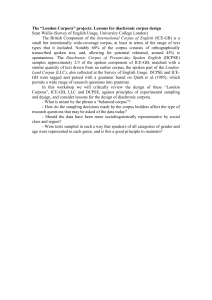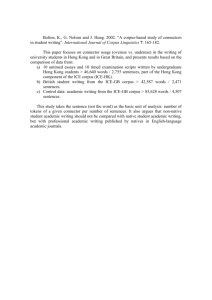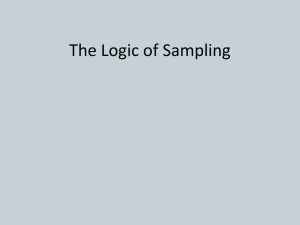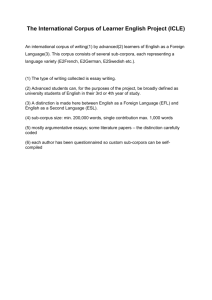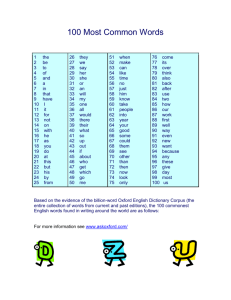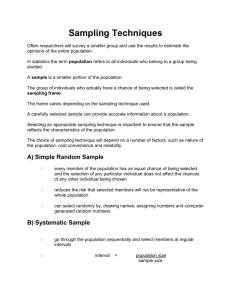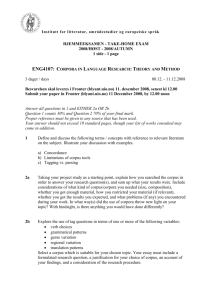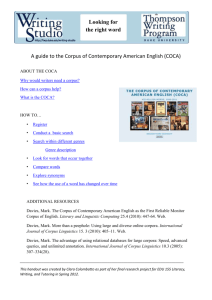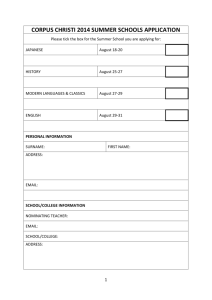PowerPoint slides
advertisement
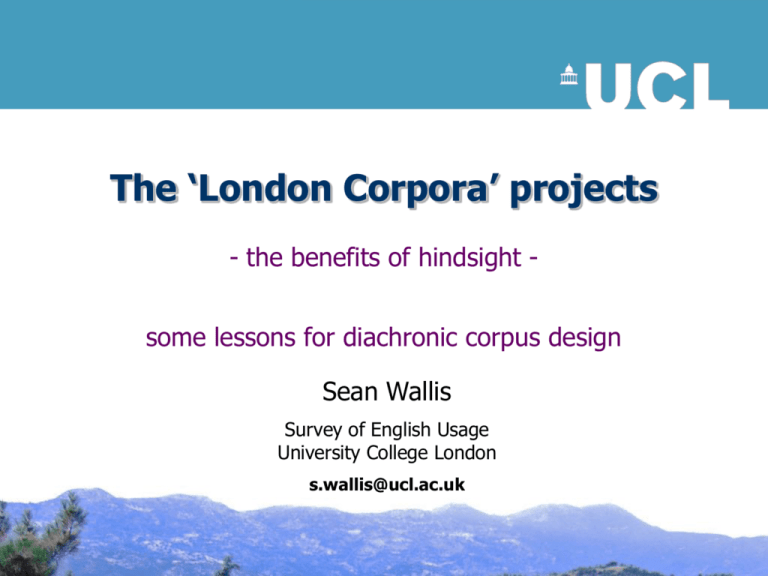
The ‘London Corpora’ projects - the benefits of hindsight some lessons for diachronic corpus design Sean Wallis Survey of English Usage University College London s.wallis@ucl.ac.uk Motivating questions • What is meant by the phrase ‘a balanced corpus’? – How do sampling decisions made by corpus builders affect the type of research questions that may be asked of the data? Motivating questions • What is meant by the phrase ‘a balanced corpus’? – How do sampling decisions made by corpus builders affect the type of research questions that may be asked of the data? • Reviewing ICE-GB and DCPSE: – Should the data have been more sociolinguistically representative, by social class and region? Motivating questions • What is meant by the phrase ‘a balanced corpus’? – How do sampling decisions made by corpus builders affect the type of research questions that may be asked of the data? • Reviewing ICE-GB and DCPSE: – Should the data have been more sociolinguistically representative, by social class and region? – Should texts have been stratified: sampled so that speakers of all categories of gender and age were (equally) represented in each genre? ICE-GB • British Component of ICE • Corpus of speech and writing (1990-1992) – 60% spoken, 40% written; 1 million words; orthographically transcribed speech, marked up, tagged and fully parsed • Sampling principles – International sampling scheme, including broad range of spoken and written categories – But: • Adults who had completed secondary education • ‘British corpus’ geographically limited – speakers mostly from London / SE UK (or sampled there) DCPSE • Diachronic Corpus of Present-day Spoken English (late 1950s - early 1990s) – 800,000 words (nominal) – London-Lund component annotated as ICE-GB • orthographically transcribed and fully parsed • Created from subsamples of LLC and ICE-GB – Matching numbers of texts in text categories – Not sampled over equal duration • LLC (1958-1977) • ICE-GB (1990-1992) – Text passages in LLC larger than ICE-GB • LLC (5,000 words) • ICE-GB (2,000 words) • But text passages may include subtexts – telephone calls and newspaper articles are frequently short DCPSE • Representative? – Text categories of unequal size – Broad range of text types sampled – Not balanced by speaker demography text category LLC (1960s) formal face-to-face informal face-to-face telephone conversations broadcast discussions broadcast interviews spontaneous commentary parliamentary language legal cross-examination assorted spontaneous prepared speech 46,291 207,852 25,645 43,620 20,359 45,765 10,081 5,089 10,111 30,564 TOTAL (51) (146) (110) (47) (12) (50) (14) (4) (8) (14) ICE-GB (1990s) 39,201 176,244 19,455 42,002 21,385 48,539 10,226 4,249 10,767 32,180 (58) (398) (30) (101) (26) (60) (58) (5) (5) (71) 445,377 (450) 404,248 (818) TOTAL 85,492 384,096 45,100 85,622 41,744 94,304 20,307 9,338 20,878 62,744 (109) (544) (140) (148) (38) (110) (72) (9) (13) (85) 849,625 (1,268) A balanced corpus? • Corpora are reusable experimental datasets – Data collection (sampling) should avoid limiting future research goals – Samples should be representative • What are they representative of? • Quantity vs. quality – Large/lighter annotation vs. small/richer – Are larger corpora more (easily) representative? • Problems for historical corpora – Can we add samples to make the corpus more representative? “Representativeness” • Do we mean representative... – of the language? • A sample in the corpus is a genuine random sample of the type of text in the language “Representativeness” • Do we mean representative... – of the language? • A sample in the corpus is a genuine random sample of the type of text in the language – of text types? • Effort made to include examples of all types of language “text types” (including speech contexts) “Representativeness” • Do we mean representative... – of the language? • A sample in the corpus is a genuine random sample of the type of text in the language – of text types? • Effort made to include examples of all types of language “text types” (including speech contexts) – of speaker types? • Sampling decisions made to include equal numbers (by gender, age, geography, etc.) of participants in each text category • Should subdivide data independently (stratification) “Representativeness” • Do we mean representative... – of the language? “random sample” • A sample in the corpus is a genuine random sample of the type of text in the language “broad” – of text types? • Effort made to include examples of all types of language “text types” (including speech contexts) – of speaker types? “stratified” • Sampling decisions made to include equal numbers (by gender, age, geography, etc.) of participants in each text category • Should subdivide data independently (stratification) Stratified sampling • Ideal – Corpus independently subdivided by each variable Stratified sampling • Ideal – Corpus independently subdivided by each variable Stratified sampling • Ideal – Corpus independently subdivided by each variable – Equal subdivisions? Stratified sampling • Ideal – Corpus independently subdivided by each variable – Equal subdivisions? • Not required • Independent variables = constant probability in each subset – e.g. proportion of words spoken by women not affected by text genre – e.g. same ratio of women:men in age groups, etc. Stratified sampling • Ideal – Corpus independently subdivided by each variable – Equal subdivisions? • Not required • Independent variables = constant probability in each subset – e.g. proportion of words spoken by women not affected by text genre • What is the reality? ICE-GB: gender / written-spoken • Proportion of words in each category spoken by women and men – The authors of some texts are unspecified – Some written material may be jointly authored female written male spoken TOTAL 0 p1 – female/male ratio varies slightly (=0.02) 0.2 0.4 0.6 0.8 ICE-GB: gender / spoken genres • Gender variation in spoken subcategories female unscripted speeches spontaneous commentaries legal presentations demonstrations unscripted non-broadcast speeches broadcast talks scripted monologue broadcast news mixed parliamentary debates legal cross-examinations classroom lessons business transactions broadcast interviews broadcast discussions public telephone calls direct conversations private dialogue TOTAL spoken male 0 0.2 0.4 0.6 0.8 p 1 ICE-GB: gender / written genres • Gender variation in written genres female press news reports reportage press editorials persuasive writing technology social sciences natural sciences humanities non-academic writing skills/hobbies administrative/regulatory instructional writing novels/stories creative writing technology social sciences natural sciences humanities academic writing printed untimed student essays student examination scripts non-professional writing social letters business letters correspondence non-printed TOTAL written male <author unknown/joint> 0 0.2 0.4 0.6 0.8 p 1 ICE-GB • Sampling was not stratified across variables – Women contribute 1/3 of corpus words – Some genres are all male (where specified) • speech: spontaneous commentary, legal presentation • academic writing: technology, natural sciences • non-academic writing: technology, social science ICE-GB • Sampling was not stratified across variables – Women contribute 1/3 of corpus words – Some genres are all male (where specified) • speech: spontaneous commentary, legal presentation • academic writing: technology, natural sciences • non-academic writing: technology, social science – Is this representative? ICE-GB • Sampling was not stratified across variables – Women contribute 1/3 of corpus words – Some genres are all male (where specified) • speech: spontaneous commentary, legal presentation • academic writing: technology, natural sciences • non-academic writing: technology, social science – Is this representative? – When we compare • technology writing with creative writing • academic writing with student essays – are we also finding gender effects? ICE-GB • Sampling was not stratified across variables – Women contribute 1/3 of corpus words – Some genres are all male (where specified) • speech: spontaneous commentary, legal presentation • academic writing: technology, natural sciences • non-academic writing: technology, social science – Is this representative? – When we compare • technology writing with creative writing • academic writing with student essays – are we also finding gender effects? – Difficult to compensate for absent data in analysis! DCPSE: gender / genre • DCPSE has a simpler genre categorisation – also divided by time prepared speech assorted spontaneous legal cross-examination parliamentary language spontaneous commentary female broadcast interviews male broadcast discussions telephone conversations informal formal face-to-face conversations TOTAL 0 0.2 0.4 0.6 0.8 p 1 DCPSE: gender / time • DCPSE has a simpler genre categorisation – also divided by time • note the gap 1 p 0.8 0.6 0.4 1992 1990 1988 1986 1984 1982 1980 1978 1976 1974 1972 1970 1968 1966 1964 1962 1960 0 1958 0.2 time DCPSE: genre / time • Proportion in each spoken genre, over time – sampled by matching LLC and ICE-GB overall • this is a ‘stratified sample’ (but only LLC:ICE-GB) • uneven sampling over 5-year periods (within LLC) p formal face-to-face ICE-GB target for LLC 0.6 0.4 informal face-to-face prepared speech 0.2 spontaneous commentary telephone conversations 0 1960 1965 1970 1975 1980 1985 1990 DCPSE • LLC sampling not stratified – Issue not considered, data collected over extended period – Some data was surreptitiously recorded DCPSE • LLC sampling not stratified – Issue not considered, data collected over extended period – Some data was surreptitiously recorded • DCPSE matched samples by ‘genre’ – Same text category sizes in ICE-GB and LLC – But problems in LLC (and ICE) percolate DCPSE • LLC sampling not stratified – Issue not considered, data collected over extended period – Some data was surreptitiously recorded • DCPSE matched samples by ‘genre’ – Same text category sizes in ICE-GB and LLC – But problems in LLC (and ICE) percolate • No stratification by speaker – Result: difficult and sometimes impossible to separate out speaker-demographic effects from text category Conclusions • Ideal would be that: – the corpus was “representative” in all 3 ways: • a genuine random sample • a broad range of text types • a stratified sampling of speakers – But these principles are unlikely to be compatible • e.g. speaker age and utterance context • Some compensatory approaches may be employed at research (data analysis) stage – what about absent or atypical data? – what if we have few speakers/writers? • So... Conclusions • …pay attention to stratification in deciding which texts to include in subcategories – consider replacing texts in outlying categories • …justify and document non-inclusion of stratum by evidence – e.g. “there are no published articles attributable to authors of this age in this time period”
